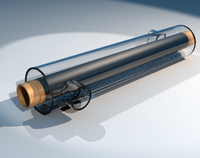
Photo from wikipedia
Abstract Aluminum plate-fin heat exchangers (PFHEs) with offset-strip fins (OSFs) are widely used in modern helium liquefaction/refrigeration systems characterized by enhanced heat transfer abilities and high compactness. This study numerically… Click to show full abstract
Abstract Aluminum plate-fin heat exchangers (PFHEs) with offset-strip fins (OSFs) are widely used in modern helium liquefaction/refrigeration systems characterized by enhanced heat transfer abilities and high compactness. This study numerically and experimentally investigated the thermal-hydraulic characteristics of cryogenic helium gas flowing through various OSF channels. Through the comparative tests conducted by well-validated numerical model as well as the contrast experiments respectively at room and nitrogen liquefaction temperatures, the results indicated that the OSF performance was not only affected by fin geometrical structures, but also deeply influenced by additional effect factors under actual cryogenic operating conditions. Based on the orthogonal table with 0.077 ⩽ α ⩽ 1.103 , 0.008 ⩽ δ ⩽ 0.15 and 0.029 ⩽ γ ⩽ 0.333 , the heat transfer and pressure drop performance of OSFs was systematically studied at a wide range of Re number ( 200 ⩽ Re ⩽ 12000 ) in three common refrigeration stages (300 K @ 12 bar, 77 K @ 6 bar and 20 K @ 2 bar). To improve the prediction accuracy of the correlations at low temperatures, the non-dimensional Pr Number and iteratively-solved fin efficiency η f that considering the thermophysical property variations of fluid and metal were introduced in the correlations of Colburn j and Fanning friction f factors. Compared with the experimental data, the proposed model had strong robustness of prediction ability, with the predicted errors of 11.33% and 22.49% respectively for j and f factors. Additionally, the effect of Pr number and η f occupied different weights in the j factors from laminar to turbulent flow. The sensitivity of the heat transfer performance with respect to each condition parameter was also discussed. Different from the most of the existing correlations derived from the fitted data based on common steam-to-air tests, the proposed correlations were more qualified for predicting the thermal-hydraulic performance of OSF channels in PFHEs through the cool-down process in helium refrigerators.
Journal Title: Applied Thermal Engineering
Year Published: 2021
Link to full text (if available)
Share on Social Media: Sign Up to like & get
recommendations!